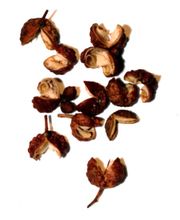فلفل سيشوان
| فلفل سيشوان | |||||||
|---|---|---|---|---|---|---|---|
 | |||||||
| الصينية التقليدية | 花椒 | ||||||
| الحروف المبسطة | 花椒 | ||||||
| هانيو پنين | huājiāo | ||||||
| |||||||
فلفل سيشوان Sichuan pepper
Composition of various species
- Z. fagara (Central & Southern Africa, South America) — alkaloids, coumarins (Phytochemistry, 27, 3933, 1988)
- Z. simulans (Taiwan) — Mostly beta-myrcene, limonene, 1,8-cineole, Z-beta-ocimene (J. Agri. & Food Chem., 44, 1096, 1996)
- Z. armatum (Nepal) — linalool (50%), limonene, methyl cinnamate, cineole
- Z. rhesta (India) — Sabinene, limonene, pinenes, para-cymene, terpinenes, 4-terpineol, alpha-terpineol. (Zeitschrift f. Lebensmitteluntersuchung und -forschung A, 206, 228, 1998)
- Z. piperitum (Japan [leaves]) — citronellal, citronellol, Z-3-hexenal (Bioscience, Biotechnology and Biochemistry, 61, 491, 1997)
- Z. acanthopodium (Indonesia)
مسميات أخرى
It is possible to come across names such as "Szechwan pepper," "Chinese pepper," "Japanese pepper," "aniseed pepper," "Sprice pepper," "Chinese prickly-ash," "Fagara," "sansho," "Nepal pepper," "Indonesian lemon pepper," and others, sometimes referring to specific species within this group, since this plant is not well known enough in the West to have an established name. In Tibet, the spice is known as e-ma or Kham pepper. At least some of the brands found in Asian grocery stores in the United States label the product in a confusing way; for instance, the Oriental Mascot brand labels the spice as "red pepper corn," although the Chinese characters on the package indicate it is Sichuan pepper. Some brands also use the English description "Dehydrated Prickly Ash" since Sichuan pepper, and Japanese sansho, are from related plants that are sometimes called prickly ash because of their thorns.
Sichuan pepper is unrelated to black pepper (genus Piper) and to chile peppers, which are also widely used in Sichuan cookery.
المصادر
وصلات خارجية
| فلفل سيشوان
]].
